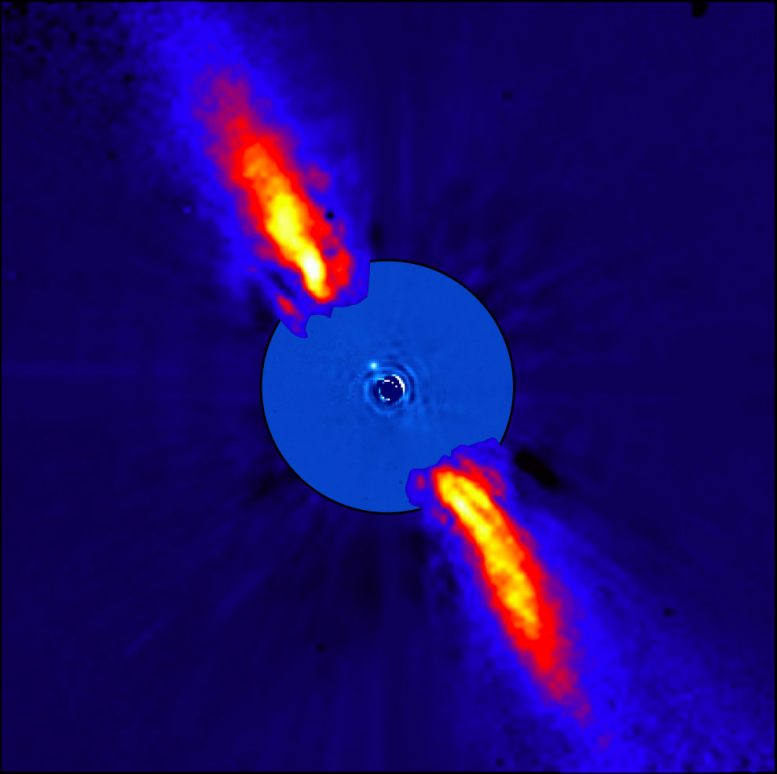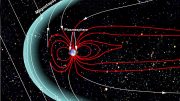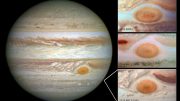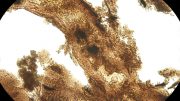
This composite image represents the close environment of Beta Pictoris as seen in near-infrared light. This very faint environment is revealed after a very careful subtraction of the much brighter stellar halo. The outer part of the image shows the reflected light on the dust disc, as observed in 1996 with the ADONIS instrument on ESO’s 3.6 m telescope; the inner part is the innermost part of the system, as seen at 3.6 microns with NACO on the Very Large Telescope. The newly detected source is more than 1000 times fainter than Beta Pictoris, aligned with the disc, at a projected distance of 8 times the Earth-Sun distance. This corresponds to 0.44 arcsecond on the sky, or the angle sustained by a one Euro coin seen at a distance of about 10 kilometers. Because the planet is still very young, it is still very hot, with a temperature around 1,200 degrees Celsius (2,200 degrees Fahrenheit). Both parts of the image were obtained on ESO telescopes equipped with adaptive optics. Credit: ESO/A.-M. Lagrange et al.
Astronomers make the most complete census of comets around another star, revealing that individual comets orbiting the star Beta Pictoris belong to two distinct families of exocomets.
The HARPS instrument at ESO’s La Silla Observatory in Chile has been used to make the most complete census of comets around another star ever created. A French team of astronomers has studied nearly 500 individual comets orbiting the star Beta Pictoris and has discovered that they belong to two distinct families of exocomets: old exocomets that have made multiple passages near the star, and younger exocomets that probably came from the recent breakup of one or more larger objects. The new results appear in the journal Nature.
Beta Pictoris is a young star located about 63 light-years from the Sun. It is only about 20 million years old and is surrounded by a huge disc of material — a very active young planetary system where gas and dust are produced by the evaporation of comets and the collisions of asteroids.
Flavien Kiefer (IAP/CNRS/UPMC), lead author of the new study sets the scene: “Beta Pictoris is a very exciting target! The detailed observations of its exocomets give us clues to help understand what processes occur in this kind of young planetary system.”
For almost 30 years astronomers have seen subtle changes in the light from Beta Pictoris that were thought to be caused by the passage of comets in front of the star itself. Comets are small bodies of a few kilometers in size, but they are rich in ices, which evaporates when they approach their star, producing gigantic tails of gas and dust that can absorb some of the light passing through them. The dim light from the exocomets is swamped by the light of the brilliant star so they cannot be imaged directly from Earth.
This video sequence is based on an artist’s impression of exocomets orbiting the star Beta Pictoris. Astronomers analyzing observations of nearly 500 individual comets made with the HARPS instrument at ESO’s La Silla Observatory have discovered two families of exocomets around this nearby young star. The first consists of old exocomets that have made multiple passages near the star. The second family, shown in this illustration, consists of younger exocomets on the same orbit, which probably came from the recent breakup of one or more larger objects. Credit: ESO/L. Calçada/N. Risinger (skysurvey.org)
To study the Beta Pictoris exocomets, the team analyzed more than 1000 observations obtained between 2003 and 2011 with the HARPS instrument on the ESO 3.6-meter (12-foot) telescope at the La Silla Observatory in Chile.
The researchers selected a sample of 493 different exocomets. Some exocomets were observed several times and for a few hours. Careful analysis provided measurements of the speed and the size of the gas clouds. Some of the orbital properties of each of these exocomets, such as the shape and the orientation of the orbit and the distance to the star, could also be deduced.
This analysis of several hundreds of exocomets in a single exo-planetary system is unique. It revealed the presence of two distinct families of exocomets: one family of old exocomets whose orbits are controlled by a massive planet,[1] and another family, probably arising from the recent breakdown of one or a few bigger objects. Different families of comets also exist in the Solar System.
The exocomets of the first family have a variety of orbits and show a rather weak activity with low production rates of gas and dust. This suggests that these comets have exhausted their supplies of ices during their multiple passages close to Beta Pictoris.[2]
The exocomets of the second family are much more active and are also on nearly identical orbits.[3] This suggests that the members of the second family all arise from the same origin: probably the breakdown of a larger object whose fragments are on an orbit grazing the star Beta Pictoris.
Flavien Kiefer concludes: “For the first time a statistical study has determined the physics and orbits for a large number of exocomets. This work provides a remarkable look at the mechanisms that were at work in the Solar System just after its formation 4.5 billion years ago.”
Notes
- A giant planet, Beta Pictoris b, has also been discovered in orbit at about a billion kilometers from the star and studied using high-resolution images obtained with adaptive optics.
- Moreover, the orbits of these comets (eccentricity and orientation) are exactly as predicted for comets trapped in orbital resonance with a massive planet. The properties of the comets of the first family show that this planet in resonance must be at about 700 million kilometers (435 million miles) from the star — close to where the planet Beta Pictoris b was discovered.
- This makes them similar to the comets of the Kreutz family in the Solar System, or the fragments of Comet Shoemaker-Levy 9, which impacted Jupiter in July 1994.
Reference: “Two families of exocomets in the β Pictoris system” by F. Kiefer, A. Lecavelier des Etangs, J. Boissier, A. Vidal-Madjar, H. Beust, A.-M. Lagrange, G. Hébrard and R. Ferlet, 22 October 2014, Nature.
DOI: 10.1038/nature13849
PDF









Be the first to comment on "Astronomers Discover Two Distinct Families of Exocomets Around Beta Pictoris"